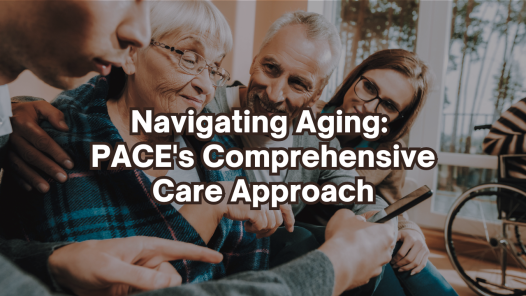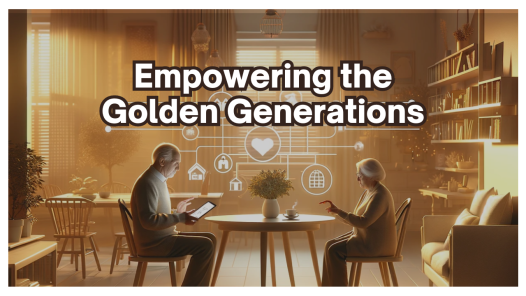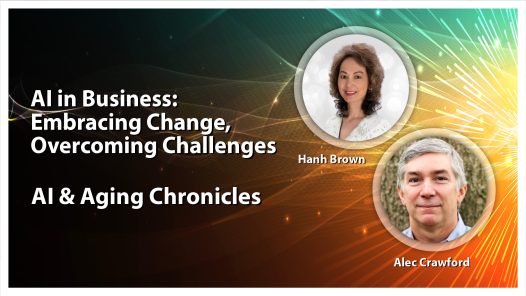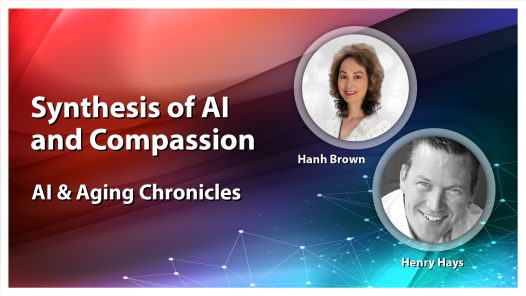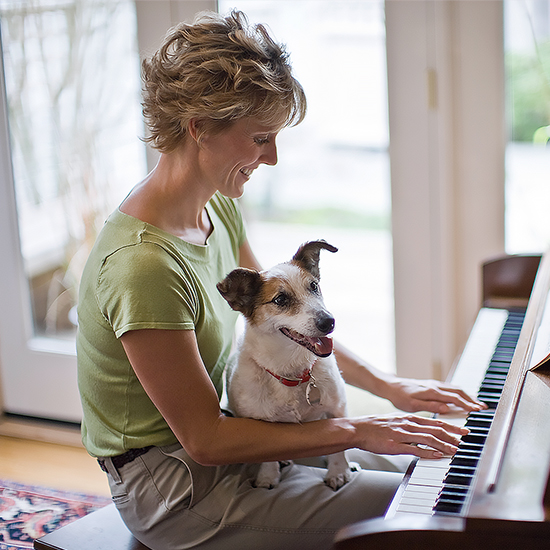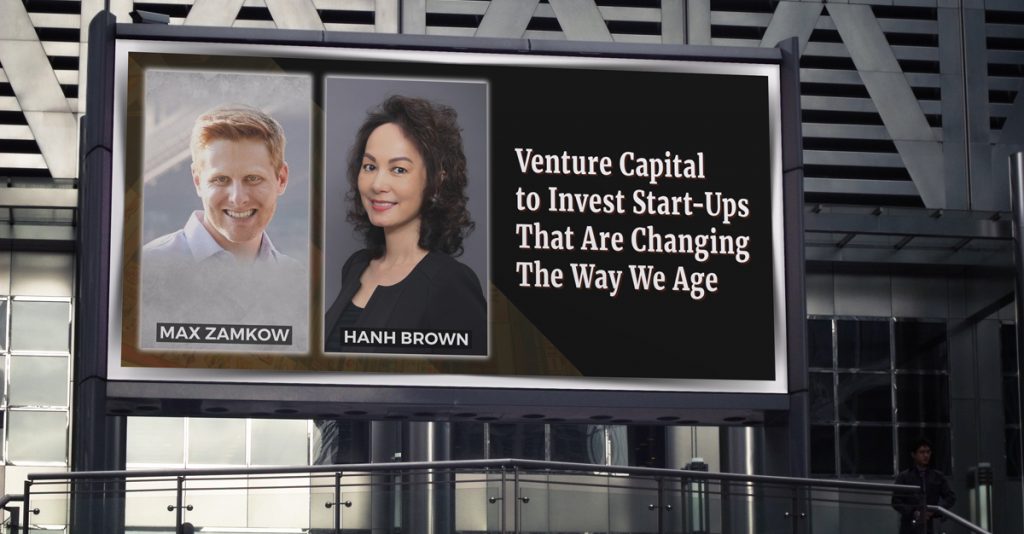
As the population ages, there is a growing need for products and services to serve this demographic.
The Baby Boomer generation is aging rapidly in the US, with over 76 million people now falling into this category. These consumers are already spending money on everything from food to entertainment, but they have yet to be targeted by many companies who want their business.
Agetech helps businesses tap into this huge market by offering products and services designed specifically for the needs of baby boomers including housing, entertainment, health & wellness, travel & leisure, home & garden, consumer electronics as well as financial planning tools like retirement calculators and other resources for retirees who are looking forward to their golden years!
——————–
Timestamps:
[00:00]Pre-intro dialogue from Max Zamkow [02:20]
Introduction [02:56]
What sorts of solutions and services does Age Tech cover? [04:29]
What is your take on the explosion of Age Tech startups, financings, and exits in the past few years? [07:29]
Do you think this large increase in Age Tech startups will continue? And if yes, for how long? [09:25]
What company you invested in, do you think is going to have the biggest tangible impact on seniors in the short term? [13:01]
Did you invest in any Visionary Age Tech companies that will change the face of senior living over a long horizon? [14:47]
Are there communities implementing such technologies like Casper or is it something that we just continue to follow and ride through this absorption for a while? [19:14]
What do you think are some of the biggest reasons Age Tech, startups fail? [23:11]
What consumer product categories will have massive growth over the next few years due to the boomer demand? [27:31]
I understand that you believe that most boomers are interested in senior living, but just not the current version of what we have today. So, can you explain what you mean by this? [30:48]
How can Age Tech help us make a transition to the next phase of senior living? [32:58]
Let’s say once we’re in the next phase, how can we market it to seniors too? So, they understand the change that has taken place? In other words, how can we get rid of some of the stigma associated with the phrase “Senior Living?” [33:37]
Do you think getting rid of, let’s say “stigma” may help combat some of the ageism that we’re seeing too often in this country? [34:36]
What do you think is your biggest strength that enables you to have a unique, impactful effect on older adults or investing in Age Tech for older adults?
——————–
Bio:
Max Zamkow is the Founding Partner of Third Act Ventures, a seed-stage Venture Capital firm investing specifically in Agetech. Since 2016 he’s made more than 22 investments across the spectrum of Agetech – from technology that helps people age-in-place, apps that help home care aides, devices that improve the quality of life in senior living, and platforms that help families deal with the loss of a loved one. Max received a BS & MS in Bioinformatics from Stanford University and before moving to the other side of the table was an integral part of Mobclix (acquired by Velti), NoiseToys (acquired by Jawbone), and Fav.tv (acquired by TVGuide.com). Max is known for his Agetech deals newsletters, co-leading Aging2.0 New York, and for successfully pitching DCM during a blackout.
Learn more about Max Zamkow here:
LinkedIn: https://www.linkedin.com/in/mzamkow/
Twitter: https://twitter.com/MZamkow
Transcript:
Max:
I will tell you firsthand that the biggest reason that Age Tech startups fail is that they forget who their customer is. They forget about the fact that their customer has a very different relationship with technology and comes from a very different set of understanding about how it works. And a lot of companies, most startups are founded by people under the age of 40 who are not older adults. So, you’re designing something for a product, for someone who has a very different life experience than yourself. And many forget that, and don’t put enough time and effort into designing with, or really having older adults do more than designing them themselves. The other issue is it’s a very complicated market. And with almost all of these solutions, the person who’s buying it is not necessarily the person who’s using the technology. If we’re talking about senior living, it’s some administrators making that buying decision, but it could be out of the residents or the frontline staff or the activity director. They’re the ones who are using it on a regular basis. And far too often, unfortunately, very well-intentioned products were sold, but they didn’t think about how it would make the end user’s life better, easier. And so, it failed in either making, if it was for a resident who made them feel old and feeble, and that’s the life alert story. Who wants to wear a pendant around their neck, that reminds them every day that they’re old?
Hanh:
Max Zamkow, co-founding partner of Third Act Ventures joins me today on Boomer Living. Third Act Ventures is a seed stage venture capital firm investing specifically in Age Tech with more than 22 investments in Age Tech in the last five years degrees in bioinformatics from Stanford in a popular age check views newsletter. So, I’m excited to learn today from all of his experience. So Max, thank you so much for joining me today on Boomer Living.
Max:
Thank you so much for having me.
Hanh:
Great. So, let’s start with a quick definition. So, we’re all on the same page. What sorts of solutions and services does Age Tech cover?
Max:
Sure. And that’s a great question and is certainly changed in the last, five, six years as I’ve been investing in this space. Like most people, I started out thinking it was just products for anyone over 65. I think that’s expanded now to really boomers and even a little bit before boomers as well. Anyone who’s starting to think about any, everything past their primary career, trying to figure out whether it’s retirement, second career, what they want to do with their lives, how they’re going to make sure not to outspend their money, make sure they’re protected, leaving enough for their kids. And then moving into the care settings, if they’re receiving any sort of care if they’re receiving home care, if they decide to move into senior living, obviously any technology that is for the staff there that’s for the resident experience there to make that better for the administration to make them run better. All the way through death and dying, whether it’s preparing for it legally, financially, dealing with it emotionally, really anything in that spectrum, that’s working to make life better for older adults and or their caregivers. And actually, maybe not that old adults, just people that are starting to think about the next part lives.
Hanh:
Like I mentioned in the intro, you’ve made more than 22 Age Tech investments in the last five years. So, the explosive growth of age check has been driven by the increased availability and accessibility to technology, which in turn is also driving innovation and creativity on a large scale, thanks to all the startups that are making waves out there. So, what is your take about the explosion of Age Tech startups, financings and exits in the past few years?
Max:
Sure. I think it’s due to a few different factors. One is just the boomers getting towards that kind of retirement slash next step in life, age. It’s really that this has been predicted for a long time. There have been articles in the papers and radio, whatever saying that, the boomers are coming, they call it the Gray Wave or Tsunami or whatever Disaster they want to call it. I think it’s actually the opposite. It’s a huge opportunity. But the fact is that with that, we’re also, we’ve made such great strides in health care that we’re able to live a lot healthier, a lot longer. So, there’s been all this anticipation, this build up of all this, demand for senior housing, for home care. And that hasn’t materialized yet because boomers, and even those a little bit older than them are still healthy at home and trying to stay that way as long as possible, which means that for the first time, all of these facilities have to actually think about how do we market and sell and get people to want to come here. You go back 10, 20 years and there was just so much latent demand for senior living that you just put up a building and it would instantly fill up. And they’re not used to having to actually do any selling. And so, now for the first time they have to start figuring out “How can we attract people to want to move in here?” And so, that has caused them to look outside their normal bounds and look for technology that would help them do that, help them improve their margins because they’re getting a little bit hurt again on that low occupancy, working on keeping people healthier in there longer, because that also has the same effect. Then, COVID comes and just wipes that out even more so and further, further enhances this idea that most Americans have, which is that they want to stay at home as long as possible. So, now this issue that was already there has just been exacerbated, hugely. And also the boomers have started to pick up on a lot of these technologies that have been created for them. Six years ago when I first started, it was hard to find any companies that were having success in this space outside of maybe traditional senior living. And, but there have been quite a few that have been able to figure out how to market and sell effectively, and that had been picked up. And later stage investors have started to see that I’ve started to learn and realize the opportunity that’s coming and that kind of, all that deal flow kind of feeds back into the system. And so, it started to make that flywheel go around, which is really exciting.
Hanh:
Absolutely. Yeah, I honestly. I can’t keep up with the day-to-day acquisitions and growth that I see in the Age Tech sector.
Hanh:
So, now do you think this large increase in Age Tech startups will continue? And if yes, for how long?
Max:
That’s a great question. Yes, I am very confident, it will continue. For how long is a great question. And I think it’s, I don’t know exactly when the peak of this is going to be, but we are still a long ways off from it. If this is a baseball game, maybe we’re an inning two, of where Age Tech is going. And again, that’s really driven by the aging of society, not just America all over the world. And it just presents this giant opportunity for companies to make products and services to service all these consumers that are already spending, I think the AARP just came out with the number of 56 cents of every dollar spent in the U S is spent by someone over the age of 50. So, they’re already the biggest consumers in the country. And it’s only, now that companies are starting to target and actually make products for them and not for Millennials or gen Z. So, they can tik-tok around, which is fun, but it’s a very different kind of thing. Again, I don’t know if the peak of this is going to be in five years in 10 years in 15, certainly as the boomers get older and depending on what happens in terms of medical technology, as well as other crazy events that we can’t predict. That all kind of shape a little bit of how fast this grows, but there’s no stopping it. At the end of the day, we are going to be an Aged Society, which means that most of the individuals are going to be on the older side. And so, as long as there are that many consumers there, we’re going to have a huge market for Age Tech. And then so, this market is only going to keep growing forever.
Hanh:
I echo what you’re saying. If this was a seventh inning, ninth inning baseball game, we’re still very early second inning or so, so that’s great. So, what company you invested in, do you think is going to have the biggest tangible impact on seniors in the short term?
Max:
In the short term. That’s a really good question.
Hanh:
And long.
Max:
Sure. I’ll give you a couple. Obviously over the last year, I was lucky enough to invest in a couple different telehealth companies just before the pandemic that have done outrageously well, unsurprisingly. People already, were not, didn’t really want to go to the doctor’s office if they didn’t have to. Often a lot of people didn’t have access to the specialties that they needed. And particularly if there was some incident a lot of these technologies were already helping people avoid going to the hospital if they didn’t need to. With a pandemic here and not being able to go to the hospital, they’ve done a really great job and that’s not going to go back in the bag. And these technologies are not going to go away. They’re just going to keep getting used because, (a) they are incredibly cost-effective, and (b) providers have seen how effective they actually are in terms of outcomes. And so, that combination once they broke that barrier of will, this actually work, which has totally been blown through now, and those things are going to stay and keep people at home longer, healthier, and, or in their residents, as long as help, healthier as well. A couple others that are poised to help in the short term and really in the longterm. One of them actually is called Care.Coach. What they make is basically a virtual assistant that is backed by AI, but also a human-in-the-loop, that is constantly talking to and checking in on individual to make sure that they’re taking their meds, that they’re feeling okay, that they’re getting out, that they have all the things they need to live a healthy and happy life, and will alert someone, whether it’s a family member, a loved one a staff at a home care agency or someone else who needs to step in when they notice that something starts to go wrong. So, there’s a lot of work being done in this kind of remote monitoring area. This one I don’t like to call remote monitoring because it is very much a two way interaction between the individual and this device. It’s actually an avatar of a dog or cat, which seems kitschy, but people love talking to it. There was even an article, I think it was in the LA Times, a few years ago about an individual who became so attached to their avatar and the person behind attached to them that when they passed away, the avatar actually came to that funeral and the person behind it was actually there to be with the family and be present because they had such a strong relationship. So, unlike these kinds of remote patient monitoring things, we’re seeing where it’s like sensors that are watching you all the time, which no one likes the idea of that, but we’ll do, if we, if it keeps us out of keeps us staying in our own home. This is very much a two way desired interaction. And they are doing phenomenally well at make, keeping people happy, healthy, safe, not isolated in wherever they’re living, which is really amazing. Care.Coach.
Hanh:
So, it’s usable for folks aging in place and even usable, anywhere they live. Whether it’s in a community. Okay. All right. That’s what I thought.
Max:
And it’s really easy. It’s just a tablet that you talk to. So, there’s no buttons. There’s no swiping. There’s no anything. It’s just a screen that you talk to and it talks back, just like a real person would be.
Hanh:
Awesome. All right. Now are you invested in any Visionary Age Tech companies that will change the face of senior living over a long horizon?
Max:
Sure. Actually I just invested in one called Casper AI, and what they do is they are outfitting senior living communities and making them incredibly smart and luxurious. So, they’re using all sorts of different sensors and motors to be able to, be able to talk to your house and tell it to turn up the heat, open the shades alert you if you accidentally keep the oven or stove on. Can also do things for the community or for health wise that if you fall, it’ll alert someone. If there hasn’t been activity, if it looks like you haven’t gotten out of bed after a certain time, and they’ll check on you. Really making these and these apartments, these units, not just again, not about monitoring, but more about luxury because that’s what these places should be. And these could be these need to be places that people want to go to, want to move out of their house, to go to, because life is easy and fun and luxurious, and this is a simple way that hotels have been doing for a long time. And this is bringing it to the senior living industry, which costs as much, if not more than a hotel. And there’s no reason why these can’t feel like that as well. And I think that is a potential. It’s relatively simple where it is, but has the capability to do a lot of really interesting work, particularly in terms of its artificial intelligence and making people happy, safe, and comfortable. But again, going after it in a way that’s all about, Luxury and Happiness and Comfort.
Hanh:
Now as you know, the margins are thin. I think most of us, regardless of the sector, but particularly the senior living sector. The margins are thin occupancies low. So, are there communities implementing such technologies like Casper or is it something that we just continue to follow and ride through this absorption for a while? Because obviously technology is part of, moving forward that we need to have, but at the same time it’s very difficult at the moment. Do to everyone is still absorbing the loss.
Max:
Yeah, it’s true. So, there are already communities using Casper. I think they’re there in 15 plus communities. It could be actually, it could be way more at this point. But that is already coming. There are a bunch of technologies, that yes, we may have to wait and see for because they are quite expensive, but there are a lot that are actually relevant, really affordable, that can have a huge impact, not just on resident experience, but sales as well. A great example of that is a company, I invested in relatively early in my investing days called Ever Sound. What they make is wireless headphones that are used, initially they were used for all group activities. And, but now they’ve actually made products that help, particularly during COVID, so you could have a meeting with your loved one and hear each other, like through, through glass. So, one loved them could be outside. You could be inside and actually have that conversation, which you couldn’t do when all these places were closed during COVID. And that they’re actually also using unsurprisingly during sales and marketing tours now. And the concept is simple. Wireless headphones have been out for a long time, but the reason why, they’re so important is that in these facilities, our hearing goes, as we get older, it just naturally happens. And a lot of us do not use hearing aids for one reason or another either they’re too expensive or there’s a huge stigma around them. We don’t want to feel old. Or they actually don’t work very well. And unsurprisingly, when you leave your home and community that you’ve lived in and move into a new place, if you can’t hear what other people are saying, it’s really hard to connect and actually meet people and participate. And what happens, and this happened to my grandmother, I saw it firsthand is that you just isolate yourself. You become really depressed. She stopped eating and was reverse cycling. Wasn’t sleeping. It was really shocking and a big part of that was because she just couldn’t hear. And so, these are headphones that have no stigma. They’re very easy to use. They can be used also with a hearing aid and they’re designed specifically for older adults. So, they’re again, super simple. And all of a sudden people that were not participating weren’t eating are going to classes are, joining in sing competitions. Are going to lunch and eating with their friends and it’s huge. And then again, it’s also helping on the sales and marketing, as people are touring around with these. It really sets that community apart from others and shows how focused they are on making the residents happy, which is at the end of the day, how most people make that decision. And once that base level of care is established And so, they are doing great on both fronts, really helping on the sales and marketing and all of the technologies that I invest in, and that I’m looking at, they all have an ROI for the community. They should all actually help these communities make money, and relatively quickly, we’re not talking about multi-year payback periods. We’re talking three months, six months, maybe a year and a half at the most. So, it is an investment by the company initially. And so they do have to take that hit a little bit, but these are all things that they have shown to actually be able to improve those metrics and actually help the community make more money while also providing better care, which is the goal.
Hanh:
Absolutely. So, what you’re saying is these Age Tech that you’ve invested or looking into their selling points to the prospective residents to move in so that they can live perhaps even, luxuriously let’s say.
Max:
Exactly. And on the other side, they’re also ones that are helping the staff be more effective, make their jobs easier so that these places can run with slightly fewer staff or could take better care of the residents. And in that way, it also helps the facility save money, make more money, improve their margins.
Hanh:
So, obviously not every startup can be a successful business idea. So, what do you think are some of the biggest reasons Age Tech, startups fail?
Max:
Sure. I will tell you firsthand that the biggest reason that Age Tech startups fail is that they forget who their customer is. They forget about the fact that their customer has a very different relationship with technology and comes from a very different set of understanding about how it works. And a lot of companies, most startups are founded by people under the age of 40 who are not older adults. So, you’re designing something for a product, for someone who has a very different life experience than yourself. And many forget that, and don’t put enough time and effort into designing with, or really having older adults do more than designing them themselves. The other issue is it’s a very complicated market. And with almost all of these solutions, the person who’s buying it is not necessarily the person who’s using the technology. If we’re talking about senior living, it’s some administrators making that buying decision, but it could be out of the residents or the frontline staff or the activity director. They’re the ones who are using it on a regular basis. And far too often, unfortunately, very well-intentioned products were sold, but they didn’t think about how it would make the end user’s life better, easier. And so, it failed in either making, if it was for a resident who made them feel old and feeble, and that’s the life alert story. Who wants to wear a pendant around their neck, that reminds them every day that they’re old? That’s why they don’t get used. Same thing for nurses, they already, or staff members, they are already incredibly busy. You can’t add something to their plate unless it actually makes their job easier. And so many products have failed in that. And so, as soon as the administration stops forcing them to use it after a few months, they stop using it because it again makes our life harder. Why would you do that? If it doesn’t benefit you? So again, it’s a really hard market because of that. And I think that’s a big reason why we’re only starting to see innovation pickup now, but it’s still so early because it’s a lot harder than most. There are a lot of different stakeholders that you need to satisfy in order to make a solution successful. These stakeholders generally have very different life experience again than you, and the people that are running it, which makes it a really challenging market. But it’s also why there’s so much opportunity and why we’re starting to see successes. People are starting to figure that out.
Hanh:
And I think it’s crucial to be designing Bottom-Up as opposed to Top-Down, right? Just like everything you described. Folks who are developing, designing, creating all this is likely to be forties and below, but you’re also developing 50 plus, 55 plus. And some were in the middle, because like you say, let’s say if it’s in a community than likely the people that signing up for this could be the operator, the executive director before it even gets to the user who likely may be 75 plus. So, there may be several, then no, actually there are several stakeholders that you have to sell. You have to convince.
Max:
Exactly. And it’s not easy to make something that works for everyone.
Hanh:
Great. Yeah. Yeah, I agree.
Max:
So, you have to involve them in the process as much as you can.
Hanh:
So, the baby boomer generation is growing older and they are changing the world. Aging boomers want to live their lives as independently as possible for as long as possible. So, they’re looking for Tech Enabled solutions that make life easier and more enjoyable, but with a rapidly changing population and finding innovative products, it’s been difficult in an industry where most of the offerings have been outdated and clunky, just so what you just described. So, what consumer product categories will have the massive growth over the next few years due to the boomer demand? What do you think?
Max:
Sure. That’s a really good question. Certainly, focusing on the things that boomers already are doing or want to keep doing. So, living independently is a huge one. So, anything that can help them do that. And some of those are on the care side, again, helping the insurers, their doctors keep them healthier at home as long as possible. Boomers are okay with that, as long as it doesn’t feel too invasive. I personally, would love my doctor to be able to know on a minute by minute basis of exactly how I’m doing and call me and tell me if I’m doing something that like, something’s going to happen. Hey, your heart’s looking bad. Come in and see me before you go to the hospital.” We’re getting there slowly and boomers are also, I believe really okay with that and excited. This has been the whole, this whole wellness movement in the west over the past, five, 10 years. And everyone is really focused on, maintaining that wellness. We all now have, or at least my wife has now a nutritionist on her app and doctors via telehealth, that’s something that’s coming to help people, older adults and help boomers, continue to live their lives. I think the other areas that are really interesting are financial products helping boomers, maintain their wealth, while, and make sure that they don’t outlive their wealth. And that’s one of the biggest fears that anyone who’s reaching the retirement age plus is thinking about, and it’s particularly acute for boomers because they’re the first generation that where most people didn’t have a pension to fall back on. Their parents really, that was the thing of the time. And that was really gotten rid of for the boomers first. And certainly for us, as us coming on too. We’re also worried about that. So, we need new solutions to help ensure that we don’t outlive our money and that we can focus on making sure that we’re able to do that. Some interesting ones happening right now that are essentially being Robo Advisors, but instead of for Wealth Accumulation, it’s their Wealthy Accumulation. So, helping make sure again, figuring out exactly where you should be selling positions, how you can maintain as long as possible. Other ones that are really interesting are ones that are enabling boomers to live, happy fulfilling lives. So, whether that’s, for helping find volunteer opportunities, helping find second careers, other ways to give back or continue to can. Exactly. Entrepreneurship is a huge one. Really, it used to be 65 was picked as like the retirement age, because people only lived until 70, maybe. Now we, at 70, we look like 40, what that used to be. We still have so much more to give and boomers know this, and they want to keep contributing. They want to keep doing things. A lot do want to have that traditional retired life. My aunt and uncle live in the villages in Florida. They love it. I went and visited. I was ready to retire when I was there. I get it. But a lot of people don’t want that life. A lot of people want to continue to be active. They want to, again, be an entrepreneur there’s so much time. And I’m actually meeting with a lot of entrepreneurs now in their sixties, seventies, I’ve even met a couple in their eighties, as well. And there’s so much they can do. And again, going back to what we were talking about before, because they are actually in that demographic, they’re generally better at designing and making products for boom, other boomers because they’re boomers and older themselves. They actually know what they want and how to make it work. So, I think those are the biggest exciting, are the really exciting opportunities. Obviously they’re huge shifts in the way that care is being provided and taken apart, and a lot of stuff moving into the home. The Hospital at Home Movement, I think is a great one. That’s going to help a lot of people stay in their home a lot longer. So, that’s obviously a huge area as well, but that’s talked about a lot more.
Hanh:
Sure. Sure. So, I think the general feeling or the impression that I have is that most boomers aren’t interested in moving into senior living, at least the current design of senior living. They want to be more independent much longer. They’re not ready yet. So, now I understand that you believe that most boomers are interested in senior living, but just not the current version of what we have today. So, can you explain what you mean by this?
Max:
Sure. Again, my aunt and uncle are down in the villages. They’ve been there for a while. They love it. I have other boomer friends, family friends of mine that have moved into, left their initial residents downsized, or actually it was up-sized but downsized in terms of upkeep and maintenance and upgraded in terms of amenities, facilities, et cetera. There are, boomers do generally want to move on and move into other areas where there are, they can be with their friends. They can, again, not have as many responsibilities. They don’t need to have, the, at home that they grew, all their kids grew up in because they don’t need all that space. There’s a lot of upkeep with that. They want to go somewhere. They just don’t want to go to what senior living looks like now. And as we talked about before, senior living still looks the same as it did 20, 30 years ago. It’s this giant institutional, almost like hospital, like building. Who wants to move into that? Again, go back to the seventies when these were generally started and you understand that they’re, what they’re coming from was nothing or nursing homes to senior living. That was a huge step up. But now boomers have seen that. They see that what happens there. What the experience is like. They’ve seen their parents go in there, and they want nothing to do with that. What they want is something that’s very different. That’s focused more on the things that they’re already focused on wellness, independence. And that can help in, help them do those things or help provide the care that they need. But not forcing them to live in something that, again, looks like a hospital. And so, senior living just needs to evolve from this idea, that version one, which was this giant institution into something that looks a lot more like retirement communities that exist now, into things that can help them be more independant, or even senior living is just allowing them to stay, basically where they’re living and bring the services to them and bring them in once in a while, if they need to go into an institution. I personally, can’t tell you what senior living needs to move into. I learned early on in this industry that my ability to predict what’s coming around the corner is zero. Again, I am not an older adult. I’m not a boomer. I don’t work in the industry directly. So, I don’t pretend that I know what is coming or what it needs to look like. But I do know that boomers are interested in living with other old, older boomers. They are interested in moving to places that make their lives easier and enable them to keep doing what they want to do and provide the care that they need. Just that option doesn’t exist now.
Hanh:
That revamp is in progress. And I think there are so many communities doing a phenomenal job. But absolutely, there’s a lot of room for improvement and it’s happening. So, I’m excited to see what’s on the horizon.
Hanh:
Now, Age Tech is changing the way seniors think about aging and providing technologies that empower them with greater mobility, safety, and security at home. And of course, allowing them to remain independent as long as possible and maintaining their dignity. So, how can Age Tech help us make a transition to the next phase of senior living? I know we touched on that previously, but how do you see Age Tech integral, helping us transition to the next phase of senior living?
Max:
Sure. I think one thing that I know, I, and some other investors in this space have talked a lot about is the ability of senior living to move outside of the confines of its walls and to start bringing in the community more. And as in, particularly in that, other bloomers, older adults that are getting closer to that to start including them earlier and using technology to do so, using technology to reach out, to provide, when you don’t need to move into a facility yet when you can still remain mostly independent, be able to provide the services that senior living facility provides outside of those walls and start bringing them in as well, not just for care, but for activities for fun for that fulfillment. Again, making that, making them more exciting, happier places, getting them to know, helping them get to know the community that they will one day join, Right now.
Hanh:
It’s like an Upstream Forward Feedback.
Max:
Exactly. Upstream Forward Feedback is a great way of putting it. And really just allowing these facilities to become a part, not of the lives of the whole community around them. And again, helping it helps with marketing. It helps with, nurturing these leads, which will take longer. But it also helps make these places more appealing for the current residents as well, and anyone moving in. And I think that’s a really good way that technology can help, these facilities and help create this next level of senior living.
Hanh:
That’s great. So, let’s say once we’re in the next phase, how can we market it to seniors too? So, they understand the change that has taken place? In other words, how can we get rid of some of the stigma associated with the phrase “Senior Living?”
Max:
That’s a really great question. I have no idea. I wish I had a really good answer for you. But again my knowledge of exactly how to market to this industry, how to market to boomers. We’re still just figuring that out. And by we, I mean, experts in the field. I just try to find those people, and when I see what they’re doing, invest in them, but they could tell you a lot more.
Hanh:
So, do you think getting rid of, let’s say “stigma” may help combat some of the ageism that we’re seeing too often in this country?
Max:
Yeah. The stigma is huge and I think that’s a huge part of it. The other part of it is that we’re just a youth focused society, which again, I think is something that is slowly starting to change. And we’re seeing typically celebrities who are in their fifties, sixties, seventies, eighties start to come out and, show their beauty. And so, the beauty isn’t about being 20 years old. It’s about being who you are and taking care of yourself and really being, having the confidence and wisdom that comes more from age than being 18, 20 year old knucklehead, like I was, and we all were at the time. So, I think that’s a huge one, but yeah. I think changing the stigma around this around a lot of the other things around senior living will do wonders. I’m sure it won’t quite be enough. But it will certainly be helpful.
Hanh:
All right, great. So, one more question. So, what do you think is your biggest strength that enables you to have a unique, impactful effect on older adults or investing Age Tech for older adults?
Max:
Sure. My biggest strength is, it’s actually twofold. It’s one that I do not at all, pretend like I am an expert or not more knowledgeable than anyone else in this field. So, I am able to come to every idea that’s presented to me with an entirely open mind and focus almost entirely on the data. And by data, the users. Focusing entirely on, not just whether this can be sold, but focusing on how is this impacting the lives of those people that are actually using it and taking my own subjective opinions about a product totally out. And that enables me to really see what has a potential to work because underlying, what’s underlying it, the way that it’s helping is helping those people who are using on a daily basis, as opposed to focusing on how much can you sell? How big can this be? If you’re able to convince people just to buy it and not thinking about the usage. And I think that plus, I was an entrepreneur before I was an investor. I’ve been through the struggles of being an entrepreneur, I can entirely relate. And so, I am very gentle and understanding and I focus really on providing value. And one of the best ways I can do that is by not being a pain in the butt, honestly, not pretending like I am, by putting some money in that I am going to get, to have to be a part of every decision. That I’m there to be a resource I’m there to enable them. I’m there to cheer you on and there to help console you. Provide a little bit of advice, but they are the experts, at the end of the day. I am not an expert in any one of these businesses. I just get to sit at this nice high level. So, I’m there for them. I’m there to support them. And I am not nearly as knowledgeable as they are. And I think understanding that makes me really effective in what I do.
Hanh:
Thank you so much. I appreciate your time and our conversation and learn more about you and your work. It’s very exciting times.
Max:
It is. Again, thank you so much for having me here. It really is, really exciting. I think we’re going to see a lot of growth and we’re going to see it, for a while now. Again, we’re still on inning two, of where this industry is going. There’s going to be a lot of change. It’s going to be exciting. It’s going to be scary. But there’s a lot of ability to help a ton of people and to make a lot of money doing so. So, it’s really exciting to be here. Thank you again.
Hanh:
Thank you.





